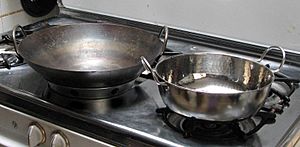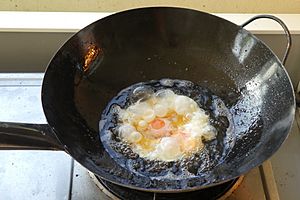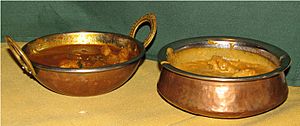Karahi facts for kids
A karahi is a special cooking pot. It is thick, round, and deep, much like a wok. This pot first came from the Indian subcontinent. People use karahis in Indian, Pakistani, Bangladeshi, and Nepalese cooking. You can also find them in Afghan and Caribbean cuisine.
Traditionally, karahis were made from strong metals like mild steel or wrought iron. They looked like woks but had steeper sides. Today, you can find karahis made from stainless steel, copper, or with nonstick surfaces. Some have round bottoms, and others have flat bottoms.
History of the Karahi
The word "karahi" or "kadahi" comes from an old word called "Kataha." This word is mentioned in ancient texts like the Ramayana and the Sushruta Samhita. The karahi cooking pot was first talked about in the Vedas, which are very old Indian scriptures. There, it was called "bharjanapatra."
How Karahis Are Used
Karahis are great for frying many different foods. You can use them for shallow frying or deep frying. People fry meat, potatoes, and sweets in them. They are also used for snacks like samosa and fish. Indian papadams are often cooked in a karahi too.
However, karahis are most famous for simmering stews. These stews are often called "karahi dishes" because they are cooked in this special pot.
Popular Karahi Dishes
Many delicious stews are made in a karahi. Some popular ones include chicken karahi, beef karahi, and mutton karahi. Mutton karahi usually uses goat meat in South Asia. There's also dumba karahi, which is made with lamb meat.
Vegetarian options are also very popular. These include karahi paneer (made with Indian cheese) and karahi tofu.
Karahi dishes are often cooked with a base of tomatoes and green chilies. They are a favorite late-night meal in Indian and Pakistani food. People usually order them by weight, like a kilogram, or as half or full karahis. They are often eaten with naan bread.
An upside-down karahi can even be used to cook rumali rotis, which are very thin flatbreads.
See also
 In Spanish: Karahi para niños
In Spanish: Karahi para niños




